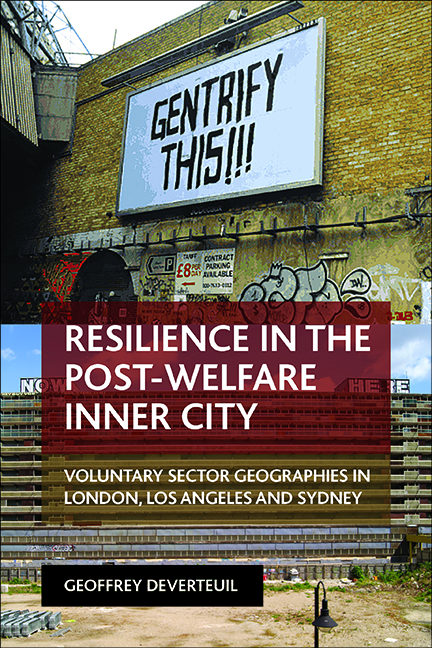 Resilience in the Post-Welfare Inner City
Resilience in the Post-Welfare Inner City Book contents
- Frontmatter
- Dedication
- Contents
- List of tables and figures
- About the author
- Acknowledgements
- Preface
- Part One Introducing resilience in the post-welfare inner city: conceptual and methodological considerations
- Part Two Case studies: spatial and social resilience in London, Los Angeles and Sydney
- Part Three Conclusions, critical resilience, commons and austerity
- References
- Index
six - Established gentrified place-types
Published online by Cambridge University Press: 10 March 2022
- Frontmatter
- Dedication
- Contents
- List of tables and figures
- About the author
- Acknowledgements
- Preface
- Part One Introducing resilience in the post-welfare inner city: conceptual and methodological considerations
- Part Two Case studies: spatial and social resilience in London, Los Angeles and Sydney
- Part Three Conclusions, critical resilience, commons and austerity
- References
- Index
Summary
Here I consider voluntary-sector resilience within the two areas with the highest levels of gentrification and upgrading: London's Westminster Borough and the Surry Hills area in Sydney. Westminster is London's showcase borough – the most visited (for example, Buckingham Palace, Leicester Square, Oxford Street, Parliament Square, Piccadilly Circus) and the most entertainment-orientated (for example, Soho, the West End) with the second-highest housing prices (after Kensington and Chelsea), but also a well-known service hub in its own right, attracting dependent populations through Victoria Station and Victoria Coach Station, as well as Trafalgar Square and the Strand. Surry Hills epitomises the dramatic reversal of fortune for most of Inner Sydney: from a 70-year legacy of grinding poverty, deteriorated housing and light industry, transformed over the past 30 years into a gentrified landscape and colonised by the higher classes. However, and despite these pressures, a significant voluntary-sector presence has remained in Surry Hills as well. As Table 5.3 showed (see Chapter Five), these two established gentrified areas experienced somewhat similar evidence of resilience and displacement as the other areas; and, from Table 5.2, I know that both featured low minority populations and medium criminalisation index scores. High and sustained levels of gentrification engendered spatial resilience among voluntary-sector organisations that was more longstanding, embedded and strategic, but at a price, as these hubs were also thoroughly entrapped within the gentrified inner-city – in some ways, frozen by the forces of neoliberalism and NIMBYism but not mortally threatened.
The experience of these two established gentrified neighbourhoods suggested several themes. The first was indeed entrapment, which can be seen as involuntary immobility but equally as spatial resilience. Hartman's (1984) ‘right to stay put’ assumed voluntary immobility, but for many services, it is involuntary immobility that is more prevalent and perhaps more vexing, involving issues of NIMBY, image management and visibility (DeVerteuil, 2012). The second theme revolved around the notion of centrality itself, in which Westminster occupies a symbolically central (both geographically and politically) location within London, if not the UK, and one which is not, and never has been, in question. This centrality translated into a highly sought but highly fraught landscape for voluntary-sector organisations.
- Type
- Chapter
- Information
- Resilience in the Post-Welfare Inner CityVoluntary Sector Geographies in London, Los Angeles and Sydney, pp. 99 - 120Publisher: Bristol University PressPrint publication year: 2015


